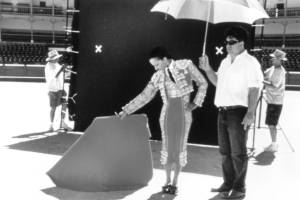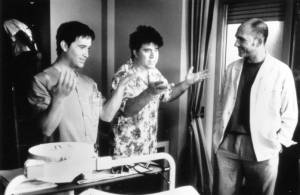Pedro Almodovar proves once again that he is a formidable contemporary filmmaker with his latest feature, TALK TO HER. The Spanish writer/director achieved notoriety and success with such previous works as Tie Me Up! Tie Me Down!, High Heels and Woman on the Verge of a Nervous Breakdown, thanks to their joyous, bawdy treatment of sex, love and gender. But Almovodar's campiness (he is openly gay) and his often lurid, outrageous plotting gave his films a cartoonish quality which did not always sit well with me. In recent years, though, he has begun to tone down and deepen his point of view toward the world, notably in the 1999 All About My Mother, which won a best-film award from the L.A. Film Critics Association.

With TALK TO HER, Almodovar has made his most moving and complex film,
one that marks his steady growth as an artist. The film has a spellbinding
quality and it touches one deeply, filled as it is with pain and sadness,
loss and longing. At the same time, TALK TO HER also has its comic moments,
and a good deal of sweetness and lightness about it.
It is this mixture
of seriousness and humor which makes TALK TO HER such an unusual film,
one whose multi-layered script is unpredictable in its narrative twists
and turns. Almovodar has also directed with uncharacteristic restraint,
keeping his actors from going over the top or becoming excessively sentimental.
This was no easy feat, considering that TALK TO HER deals much of the
time with comatose women, lonely and suicidal men.

If that description makes TALK TO HER seem morose and dark, be assured
it is anything but. Working with cinematographer Javier Aguirresarobe,
artistic designer Antxon Gomez and composer Alberto Iglesias, Almodovar
succeeds in infusing his film with a warm, glowing look, sound and feel.
Almodovar is also helped by his remarkable cast: Rosario Flores as Lydia,
a lady bullfighter; Leonor Watling as Alicia, a beautiful young dancer;
Dario Grandinetti as Marco, a brooding journalist; and Javier Camara as
Benigno, a male nurse. Geraldine Chaplin also contributes a sharply etched
performance as Katarina, a dance teacher.
Dance figures strongly
in the plot. Not only do we see Alicia studying ballet with Katrina (in
a studio across from where Benigno lives), but there are filmed sequences
of German choreographer Pina Bausch's work. Bausch's odd, avant-garde
performance pieces suit Almodovar's style perfectly, mixing as they do
the serious with the bizarre. They also serve as focal points around which
many of the characters can meet.

The most important person in TALK TO HER is Benigno. A slightly overweight,
somewhat simple-minded mama's boy, he lavishes love and attention on the
patients in his clinic, which specializes in the treatment of brain-damaged
women who have slipped into comas. Benigno not only bathes, massages and
manicures these patients lovingly, he talks to them as if they were conscious.
It's his way of keeping them alive, respecting their humanity, giving
them and their loved ones hope.
Benigno's prize patient
is Alicia, the young dancer who has been felled by an auto accident. He
lavishes her with TLC, chatting to her all the while, something that Marco
finds quite remarkable and enviable. (Marco comes often to the clinic
to visit the woman he loves-- Lydia, the lady bullfighter, who was torn
apart by one of the toros she took on). A friendship begins to develop
between the worldly but brooding reporter and the naive, goodhearted orderly.
It is a friendship that will eventually be put to the test, when Benigno
commits an indiscretion (out of love) that lands him in prison.

Friendship, communication and the impossibility (yet necessity) of love
are what TALK TO HER is all about. Serious, mature stuff, but Almodovar
also changes gears in the middle of the story and throws in something
that's a throwback to his youthful, whacky days--an hilarious takeoff
on silent films that has a sex scene to end all sex scenes. You gotta
see it to believe it.